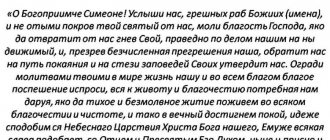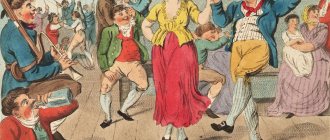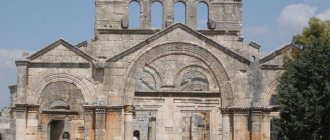One day, Metropolitan Ignatius himself came to the place where Simeon was buried. He listened to his assistant’s report that the saint’s body was incorruptible and a fragrant smell emanated from it. But the Metropolitan was skeptical about this, after which his eye became very sore, and he realized that this was punishment for his doubt. After which he himself personally witnessed the relics of the holy righteous Simeon.
Saint Simeon of Verkhoturye is revered in the Russian Orthodox Church as righteous. His memorial day is celebrated on several dates:
- December 31 is the day of his glorification;
- September 25 - the first transfer of relics is celebrated;
- May 25 - his incorrupt relics were solemnly transferred to the Holy Cross Cathedral of the St. Nicholas Monastery.
Simeon of Verkhoturye is considered the heavenly patron of the Ural land.
Simeon of Verkhoturye is the heavenly patron of the Ural land. To lead a quieter life, he went to live in the village
Simeon was born into a family of pious people around the beginning of the 17th century
Simeon was born into a family of pious people outside of Siberia around the beginning of the 17th century. Having matured, he left for Siberia in the Verkhoturye region. At that time, Verkhoturye was known as a trading place, and Simeon could not lead a quiet life there.
Therefore, he begins to live in the village of Merkushino. It was this place that was conducive to the thought of God and hermitic labors. Very often he went to nearby villages and villages for greater solitude with God.
In his free time from prayers, he was engaged in sewing fur coats. In the summer, he fished. The name of the saint became more and more famous. He also went to the houses of peasants and worked for them. Often he had to endure a lot, but he endured all the hardships.
Often the saint did not complete his work so that he would not be paid. Many people condemned him for this, but then people understood why he did this.
Simeon often spent his time in prayer. In the summer I fished, and in the winter I sewed fur coats
Simeon also visited the temple in the name of the Archangel Michael in the village of Merkushino. He always tried to treat everyone kindly. Unfortunately, Simeon died before reaching old age. His death occurred around 1642. His body was buried in a village not far from the temple.
Miraculous glorification of a forgotten righteous man
Half a century after this, the saint’s body was found incorrupt. Almost no one remembered his name. But the miracle of finding the relics of Saint Simeon amazed many: the coffin rose from the ground, through the rotten boards the remains preserved from decay were visible. Soon the relics of the saint healed a paralyzed villager, and then many other people.
Facts about the miraculous discovery of the relics were attested thanks to Metropolitan Ignatius of Siberia, who personally arrived in Merkushino and compared the righteousness of Saint Simeon with the exploits of Alexy, Metropolitan of Moscow, and Sergius of Radonezh.
Icon of Simeon of Verkhoturye
In 1704, on September 25, according to the new style, the relics of the saint were transferred to the Verkhoturye St. Nicholas Monastery. In honor of this event, every year on September 25, believers from all over Siberia flock to Verkhoturye to pray in front of the icon of St. Simeon.
On a note! Over the years, the healing miraculous power of the saint’s relics did not dry out: at the beginning of the 20th century, up to 600,000 pilgrims came to them annually.
A lot of miracles occurred from the relics of the holy righteous Simeon of Verkhoturye
There was little news about his life. But it is worth mentioning his pious life. After death, healing flows from his relics in an abundant stream. In 1692, they began to notice that his coffin began to rise higher and higher from the ground.
Through the cracks in the boards, people saw the imperishable relics. This is exactly how the Lord decided to glorify this saint, who was soon completely forgotten. Soon the relics of Saint Simeon began to be venerated. Various miracles began to occur from them.
At that time, one governor had to go to Nerchinsk. But he fell into a serious illness, his body was relaxed. He couldn't do anything on his own. Along the way he became increasingly worse, and they decided to stop in Verkhoturye.
There they learned about the relics of Saint Simeon, and hastened to his tomb. At the grave, he asked to serve a prayer service, and then took some earth from the coffin and wiped his body with it, after which he felt much better. When he became completely healthy, he began to tell everyone around him about how the Lord and the power of Saint Simeon of Verkhoturye helped him.
Through the prayers of Saint Simeon, many miracles occurred
Soon rumors about miracles taking place at the relics of Saint Simeon spread everywhere. At that time Verkhoturye belonged to the Siberian diocese. The hierarchs observed the fervor with which people prayed. They often traveled around cities and villages to make sure that there were no people who deviated from Orthodoxy.
One day they sent their assistants to this place. Assistant Matvey personally verified the relics that came straight out of the ground. He reported this to his diocese. On the spot, he told the priests to make a frame. And so it was done.
The first examination of his relics took place on December 18, 1694. The next day, Metropolitan Ignatius himself arrived at this place. He listened to Isaac’s report that the saint’s body was incorruptible and a fragrant smell emanated from it. But the Metropolitan was skeptical about this.
18 December 1694
an examination of the relics of Simeon was carried out
It is also then said that the Metropolitan’s eye hurt, and he realized that this was punishment for his doubt. After which he himself personally examined the relics. At night he received a revelation about who this newly-minted saint of God was, since at that time they did not yet know who he was.
In 1694, Ignatius visited Merkushino again to examine the relics of Saint Simeon for the second time. He ordered that information about this saint be collected. It was on the basis of these data that the life of the holy righteous Simeon was written.
What does a saint help with?
Thousands of pilgrims come to the Verkhoturye righteous man every day. People turn to him for help with various diseases. In front of the icon, they ask the righteous man to strengthen his faith, to enlighten non-believers with the light of Christ’s truth, to sober himself in everyday difficulties, in case of misfortunes and any other needs.
The name and appearance of Simeon of Verkhoturye became known thanks to a vision of the saint in a dream by Hierodeacon Nikifor Amvrosiev.
On icons, the righteous man is often depicted standing near a tree in simple clothes on the bank of a river with a scroll on which is written a call to the fear of God and purity. A monastery may be depicted in the background, and in the upper left corner on a cloud - Jesus Christ blessing the righteous.
Nowadays, there are many testimonies of the saint’s miracles. Stories about healing eye and leg diseases, recovery from cancer and tumors, and getting rid of gangrene are especially frequent.
In 1704, the relics of Simeon were delivered to the St. Nicholas Monastery in the city of Verkhoturye
On September 12, 1704, the relics of Simeon were delivered to the St. Nicholas Monastery in the city of Verkhoturye. The relics were placed in the church near the right choir. The transfer of the relics is also connected with another unusual story. It is connected with the religious procession, which was stopped by the prayer of the lame holy fool Cosmas.
Nicholas Monastery in the city of Verkhoturye, where the relics of St. Simeon are located
In 1716, the church was damaged by fire, but the shrine with the relics remained unharmed. After the restoration of the temple, they were moved to the chapel in honor of Simeon the God-Receiver and Anna the Prophetess, which was then renamed Saint Righteous Simeon. At the place where Simeon Merkushinsky was buried, a spring began to flow. After which a stone chapel was built on this site.
In 1886, they decided to organize the Brotherhood of St. Simeon in Yekaterinburg. There was one goal - spiritual enlightenment. Then a missionary fund was organized under him to help disadvantaged people who returned from the schism.
At that time, the relics of Simeon began to attract many Christian believers. It was in connection with this that the Cathedral of the Exaltation of the Cross was built next to the St. Nicholas Monastery. The transfer of the relics of Simeon of Verkhoturye took place there in 1913, when the three-hundredth anniversary of the Romanov family dynasty was celebrated.
This is what the relics of Simeon of Verkhoturye look like today
Later, the imperial family donated a carved silver canopy for the relics of Simeon. She was transferred to Verkhoturye. On May 27, the relics were transferred from the St. Nicholas Church to the Holy Cross Cathedral of the St. Nicholas Monastery.
Temples
Righteous Simeon is especially revered in the Urals and Siberia as the patron saint of these places. Temples in honor of the saint:
- In the village of Merkushino. It was built in 1886 over the place where his relics were found. Currently, this temple has been restored after destruction during the Soviet era;
- Cathedral in Chelyabinsk, the revived temple in Zlatoust, in Snezhinsk;
- Simeon-Verkhotursky Church in Ufa;
- In Perm and Solikamsk;
- St. Simeon's school in Yekaterinburg, in the village of Kolyutkino, pos. Obukhovo;
- New temple in the Ob region;
- A church under construction in Moscow (Patriarchal Compound in Maryino).
In other places there are chapels and chapels consecrated in honor of the holy righteous man. For more than three centuries, Verkhoturye has been famous for its righteous man. Three times a year, the righteous Simeon gathers pilgrims to him:
December 31/18 – discovery of the relics (1694) May 25/12 – second discovery of the relics (1989) September 25/12 – transfer of the relics (1704)
Righteous Simeon is as significant a saint for the Urals and Siberia as Sergius of Radonezh in Moscow or Seraphim of Sarov in Diveevo. Although the exploits of the saints are incomparably higher than the modest life of a simple righteous man, for the Russian soul each saint is significant in his own way and is loved no less than others.
In 1918, the first autopsy of the relics of the Righteous Simeon was performed.
In 1917, power passed to the Bolsheviks, so in 1918, Saburov’s commission performed the first autopsy of the relics of the Righteous Simeon. Archimandrite Xenophon reconciled himself with this decision. The autopsy was limited to only removing the covers from the relics. In 1918, Verkhoturye came under the control of the army of Alexander Kolchak.
A year later, the White Army began to retreat from Verkhoturye, so the archimandrite decided to evacuate the Verkhoturye Nikolaevsky Monastery and the entire population of the city. The valuables of the temple were hidden in the monastery and in the monastery of the archimandrite. The monks took with them only the reliquary from under the relics.
The archimandrite himself could not travel far, so the monks continued their journey with the reliquary. Soon on their way they came across a women's monastery, where they stopped. In 1920, they returned with the crayfish.
1989
this year the relics of St. Simeon were returned to the Russian Orthodox Church
On September 25, 1920, the autopsy of Simeon’s relics took place. In 1924, a special commission of the regional health department began to examine the relics. They decided that the ritual of applying to the relics was considered unhygienic, so they sealed the coffin. In 1929, the relics were transferred to the Tagil Museum.
In 1935, the relics of Simeon were given to the Ural Anti-Religious Museum.
In 1947, the Bishop of Sverdlovsk and Chelyabinsk wrote about the return of the relics to their homeland in the temple.
In 1989, the relics were returned to the Russian Orthodox Church, and at the same time the discovery of the relics of St. Simeon took place. The main part was moved to the Verkhoturye Monastery of the Holy Cross Cathedral.
A troparion and kontakion were written to the Righteous Simeon of Verkhoturye
A troparion and kontakion were written for Simeon, which is performed during his veneration in the temple.
Troparion, tone 4:
Fleeing worldly rebellion, you turned all your desire to God, so that in visions of the sunrise you found grief, not deviating into the wickedness of your heart, but having cleansed your soul and body, you received the grace to sharpen the healing of the faithful and the unfaithful, flowing to you, righteous Simeon. Moreover, according to the gift given to you, ask Christ God for healing for us who are sick with spiritual passions, and pray to save our souls.
Kontakion, voice 2:
You have rejected the vanity of the world, so that you may inherit the blessings of eternal life, having loved kindness and purity of soul and body. You have gained what you loved, for the tomb and incorruption of your relics, and especially the grace of miracles, testify to this. Sharpen the goals of all those who flock to you and are unenlightened, blessed Simeon, wonder-working wonder.
A prayer was written to Simeon of Verkhoturye, which can be read in front of his icon.
Prayer:
O holy and righteous Simeon, with your pure soul you may dwell in the heavenly abodes in the face of the saints, while remaining everlastingly with us on earth!
According to this grace from the Lord, pray for us, mercifully look upon us, many sinners, even if we are unworthy, but flowing to you with faith and hope, and ask us from God for forgiveness of our sins, we fall into misfortune in multitudes all the days of our life.
And just as before, to those who suffered from green diseases, they were able to heal their eyes, to those who were near death from severe ailments, and to others you bestowed many other glorious blessings:
hereby deliver us from mental and physical ailments and from all sorrow and sorrow, and ask from the Lord all that is good for our present life and for eternal salvation that is useful to us,
so that by your intercession and prayers we have acquired everything useful to us, even if we are unworthy, gratefully praising you, let us glorify God, wondrous in His saints, the Father, and the Son, and the Holy Spirit, now and ever and unto the ages of ages.
Amen.
By leaving a comment, you accept the user agreement






